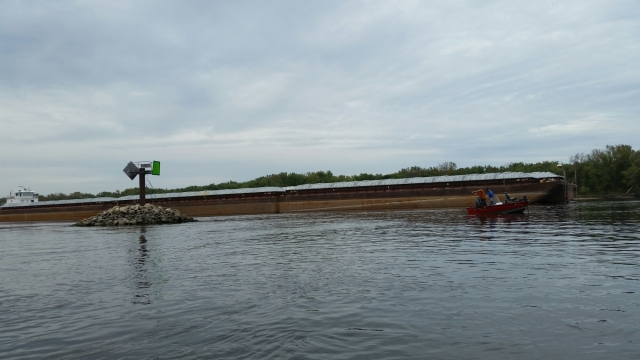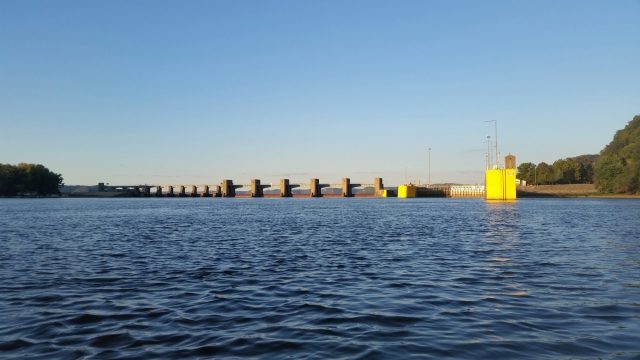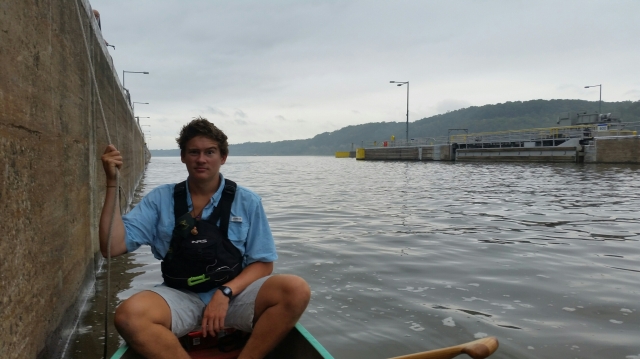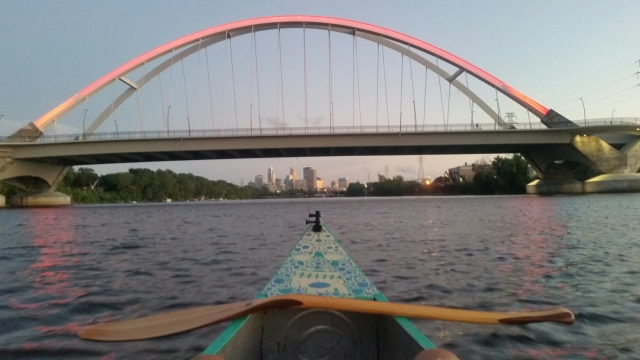On Thursday September 17th we paddled around a large bend in the river to finally discover the MinneapolisOn Thursday September 17th we paddled around a large bend in the river to finally discover the Minneapolis skyline reflecting the purple and pink hues of the setting sun. With this beautiful view of the city, and the thought of once again immersing ourselves in the luxuries of civilization, we frantically tried to find a place to stay for the weekend. We had hopelessly exhausted all options, when we were contaced by a friend in our graduating class at Loyola who is from Minneapolis, and had some friends that could help us out! We were thrilled, and hastily paddled the last 5 miles in the dark to a boat launch just above the first St. Anthony Falls Dam.
When we got to the boat launch, Jacob and Darby emerged from the darkness and helped us MacGyver rig the canoe to the roof of his 4 door sedan. Using all the rope, bungee cords, and luck we had we somehow managed to drive the canoe and all of our gear across Minneapolis. On the drive the canoe precariously slid around in all directions on the roof rack, but luckily Darby was holding it steady with an iron grip of justice through the passenger window of the car. We finally reached Darby’s house with the canoe intact, and were able to shower, do laundry, and prepare for a fun weekend in the city.
We had a blast in Minneapolis enjoying the plethora of sights, sounds, and diverse groups of people that come with any big city. When we re-enter civilization after being on the river for a while we seem to always hastily indulge in all the amenities that we miss. However, we soon begin to feel cooped up, or trapped by the city, and yearn for the simple life out on the river. We have come to look at cities, or civilization in general on this trip as amazing places to visit, but definitely not to live. We much prefer sleeping in a tent, waking up with the sunrise, cooking on a campstove, and life in a canoe.
Ready for another day on the river!
It is very important to stretch before paddling!
Since the Twin Cities the river has truly changed, as it now takes the role of one of the most active commercial highways in America. The river now has a well defined shipping channel that is ruled by massive and unforgiving barges. It is important to remember: Red Right Returning, meaning that boats headed upstream must have red bouys and markers to their right to stay in the channel. Although the channel is where the boat traffic is, it is also where the most current is moving, making it an ideal, but also hazardous spot for a tiny canoe. The name of the game is staying alert, and aware of other boats at all times so you can efficiently slip in and out of the shipping channel to avoid the traffic.

This is a channel marker and daybeacon that let’s us know what mile marker we are at. These constant markers make it very easy to navigate the big river.

The green channel marker is on his right, making it very easy to tell that this barge is headed downstream. All the fishing boat needs to do to avoid the danger is stay to the left of the green beacon and out of the channel. Easier said than done when you have a huge catfish on the line pulling you toward a barge!
Because the water level is so low, it is really important to stay in the channel to make the most of what little current there is. The Army Corp of Engineers has done a great job in containing the current in the channel by constructing numerous wing dams in the river that direct the water flow. These wing dams are easy to spot, and are marked by a heavy line in the water, followed by a patch of stillwater, or a boil that is created by the churning currents. The first wing dam we tried to cross over we actually got stuck on because the water was so low! We have figured out that our best option at the moment is to ride the current in the shipping channel, and try to stay out of the way of the bigger boats that rule the water.

Upstream view of a Lock and Dam
Along with marking and maintaining the channel, the Army Core of Engineers also has a well developed system of locks and dams along the length of the upper Mississippi, the last one being in St. Louis. The lock is essentially a huge metal and concrete chamber that they seal up, and either lower or raise the water to match the upstream or downstream water level. These lock and dams help control the water flow in different parts of the river, and work to maintain it as a usable and safe commercial shipping route.

The lock master will give you a rope to hold onto as the water level drops

A great opportunity to put your feet up and relax

The doors finally open to the downstream water level!
It is truly awe inspiring to use one of these locks in a tiny canoe. After paddling into the lock, the huge doors shut behind you, and the lock master will usually throw you a rope to hold onto as the water decends. As the water begins to empty out of the chamber, you get a strange roller coaster drop feeling in your stomach. As you decend to the downstream water level the clean concrete walls turn green with algae and mussels, exposing parts of the lock that are usually underwater. When the canoe finally reaches the downstream water level, a fog horn sounds, and the now even more massive steel doors open, releasing you into the swirling currents that flow just below each dam. It is awesome to see such a huge and complex feat of human ingenuity and engineering, and being able to actually use it to get downriver is a very humbling experience.
Relaxing, waiting to clear the Lock. Notice the water line about 5ft above our heads.


AWSOME!
LikeLiked by 1 person